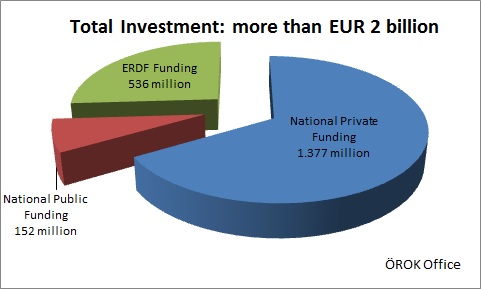THE GOAL: STIMULATING GROWTH IN AUSTRIA’S REGIONS
In the 2014-2020 funding period, one of the European Regional Development Fund’s goals is investment for growth and jobs (IGJ/ERDF). This goal applies to all European regions, which are classified into three categories: more developed regions, transition regions and less developed regions. With the exception of the Burgenland province, which has the status of a transition region in the 2014-2020 period, all other Austrian provinces are classified as more developed regions.
IGJ resources for Austria from EU Structural Funds
Compared to the previous funding period, the amount of funding allocated to Austria in the current programming period is down by almost 20 % because the overall economic situation in Austria (measured on the basis of GDP and unemployment rates) is very good relative to the EU average. In total, approximately EUR 978 million of EU funding are available to Austria for the investment for growth and jobs (IGJ) policy goal in the 2014-2020 period.
ERDF funding accounts for EUR 536 million of this total amount. These ERDF funds are distributed to the individual provinces based on an indicative allocation mechanism. As a transition region, Burgenland receives around 9% of the funds, which is a higher amount relative to the number of inhabitants than the funding allocated to the other provinces. The remaining, non-ERDF part of the total funding amount, EUR 442 million, is allocated to the European Social Fund (ESF) Employment Austria programme.
Funding priorities in the 2014-2020 period
The main topics for IGJ/ERDF funding in this period are research and innovation, the shift to a low-carbon economy, and competitiveness. The funding is intended to strengthen growth and employment in all of Austria’s regions. In particular, the IGJ/ERDF programme provides funding to projects in the five areas listed below in the 2014-2020 period. These areas are also referred to as priority axes. Roughly 90 % of the funding goes to the first three of these priorities.
Special emphasis is placed on the shift to a low-carbon economy. Approximately EUR 110 million, i.e. at least 20 % of the available IGJ/ERDF funding, are earmarked for projects related to climate protection.
- Priority 1:
Enhancing regional competitiveness through research, technological development and innovation
- Priority 2:
Enhancing the regional competitiveness of SMEs
- Priority 3:
Supporting the shift towards a low-carbon economy in all sectors
- Priority 4:
Sustainable urban development
- Priority 5:
Integrated development of urban and surrounding areas and CLLD/LEADER
Details on the 22 measures eligible for funding (in German)
Expected total investment: EUR 2 billion

ERDF funding has a special leverage effect to further strengthen investment in growth and jobs: ERDF funds require co-financing on the national level (with public and private money). Based on this mechanism, a total investment volume of EUR 2 billion is expected in Austria in the current funding period, providing a huge stimulus for the Austrian economy.
Map with funding projects IGJ/ERDF 2014-2020 (in German)
List of operations IGJ/ERDF 2014-2020

16 funding agencies (implementing bodies)
In Austria, 16 federal and regional funding agencies, also referred to as intermediate or implementing bodies, are responsible for awarding and managing IGJ/ERDF funds. These agencies are the most important points of contact for anyone interested in IGJ/ERDF funding and all beneficiaries that receive such funding.
The funding agencies provide information on the various measures eligible for funding and on the basic legal requirements and funding conditions that apply. They accept applications for funding, select projects eligible for funding, and provide continuous support to beneficiaries during the entire project duration, all the way until the preparation of the final financial statement and transfer of the payment.
Further information on the stages of a project (in German)
The relevant authorities and their roles
Funding from the European Structural and Investment (ESI) Funds is managed and implemented by authorities that are specifically designated by the individual Member States to perform all the various tasks involved.
1. Managing authority: Austria’s managing authority for the IGJ/ERDF 2014-2020 funding programme is responsible for the overall management, coordination and evaluation of the programme. Austria’s federal and provincial governments have implemented an ERDF reform agenda to streamline the administrative processes. As a result of these changes, in the current programming period the programme is now coordinated by only one managing authority, namely the Austrian Conference on Spatial Planning (ÖROK) Office. There are 16 funding agencies (implementing bodies) that are responsible for granting ERDF project funding to specific beneficiaries. The managing authority monitors and supervises the tasks delegated to these funding agencies.
2. Certifying authority: The certifying authority is responsible for managing the financial aspects of the programme. In Austria, the certifying authority is located at the Federal Ministry for Sustainability and Tourism (BMNT). In particular, the responsibilities of the certifying authority include submitting payment applications to the European Commission, receiving ERDF payments (which are transferred to the certifying authority by the Commission) and paying out the funds to the beneficiaries.
3. Audit authority: The audit authority carries out system audits to monitor and control the entire IGJ/ERDF management structure. It also conducts randomised audits of individual projects approved for funding (second level control). The Federal Ministry for Sustainability and Tourism serves as the audit authority for Austria’s ERDF programmes.
The monitoring committee
Pursuant to Art. 47 of Regulation (EU) No 1303/2013, a monitoring committee has to be established to monitor the implementation of the IGJ/ERDF 2014-2020 Operational Programme. The monitoring committee is comprised of representatives of public authorities, institutions, and interest groups. Pursuant to Art. 48(2), the list of the members of the monitoring committee has been published and is available on the following website:
List of members & Committee meetings held so far (in German)
Evaluation of the program
The instrument "evaluation" is a crucial tool for the assessment of a funding program and contributes to raising the quality of program implementation. The accompanying evaluation in the framework of the IWB/EFRE program 2014-2020 provided answers to the questions "What are the impact mechanisms and success factors for the implementation?" and "What can be further improved?". The results fed into the programming of the 2021-2027 program, here you can find an English summary of the main findings of all evaluations. The final reports in German can be found here.
Final Report Evaluation Art. 114 - English summary
Contact
For general questions about Austria’s IGJ/ERDF programme 2014-2020, please contact the managing authority at the ÖROK Office.
IGJ/ERDF managing authority contact information (in German)
Media representatives, please visit our press page, where we have put together important links and key documents and provide contact information for journalists.
If you are planning to carry out a project in Austria and would like to receive detailed information about ERDF & JTF funding in the new period 2021-2027, please visit www.efre.gv.at


